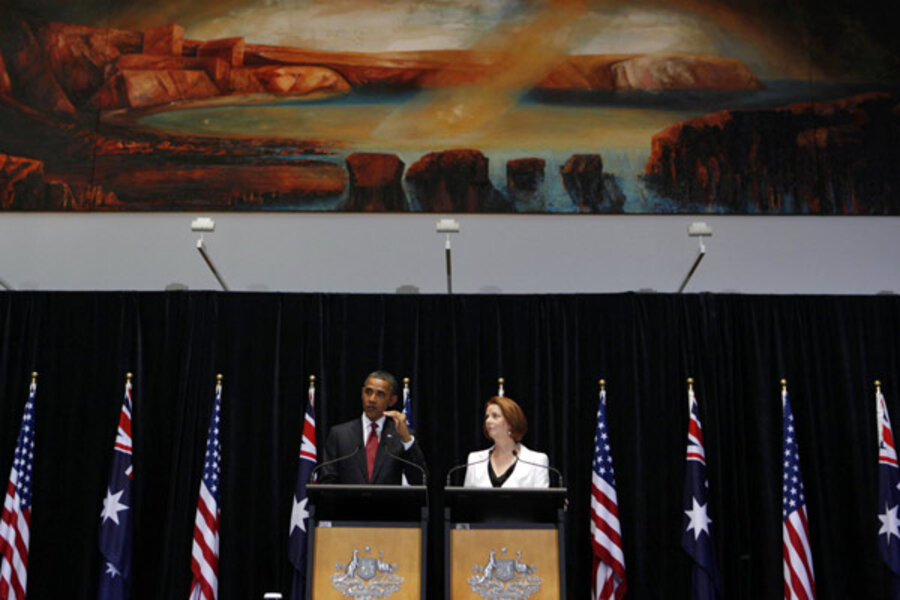New US training base in Australia is all about the rise of China
Loading...
| Washington
The news that thousands of US troops will be headed to a forward base in Australia over the next several years is a robust confirmation of what senior Pentagon officials have been predicting for months: That as the wars in Iraq and Afghanistan wind down, the US military will increasingly begin turning its attention to the Pacific.
This stepped-up focus is the result of concerns among many in the Defense Department that China is economically and militarily strong – and getting stronger by the day.
It is not only China’s ascendancy, however, that concerns senior military officials. It is equally disturbing, the officials gripe, that Chinese officials are far from transparent about both their technological advances and their intentions.
Secretary of Defense Leon Panetta emphasized these points during his first trip to Asia last month. That he took up the topic was not simply a function of his audience. He also raised the specter of China’s rise earlier in October as well, at a town-hall meeting with US troops in Europe.
“We’re concerned about China,” he told them, and it is a concern the Pentagon intends to address, Mr. Panetta added – despite the strong push to cut the defense budget during a period of economic crisis.
On this point, he has support even among lawmakers on the other side of the political aisle. China “is strategically positioning itself to militarily and economically challenge US influence and capabilities in the Asia-Pacific,” Rep. J. Randy Forbes (R) of Virginia, chairman of the House Armed Services Readiness Subcommittee, warned Wednesday.
In a statement following the release of the US-China Economic and Security Review Commission’s annual report to Congress, Representative Forbes said that the report “makes it abundantly clear that China is actively seeking to exploit the United States’ military vulnerabilities.”
It doesn’t help, Forbes added, that “Congress is busy dismantling the United States military with arbitrary cuts that could total a trillion dollars.”
Countering China’s military growth will likely require a show of strength on the part of the US military, Panetta has predicted. “The most important things we can do is to project our force into the Pacific,” he told US service members in Italy in early October. “To have our carriers there, to have our fleet there, to be able to make very clear to China that we are going to protect international rights to be able to move across the oceans freely.”
Defense officials for their part have described the US presence in the Pacific as a “realignment” of US interests.
This “realignment” comes on the heels of China’s push to build anti-ship missiles, aircraft carriers, and stealth fighter jets that could, senior defense officials warn, threaten the US Pacific fleet.
In past years, China’s proven ability to shoot down satellites in space and its proclivity for cyberincursions into US defense systems have also garnered grave warnings from US officials.
The US military presence in Australia is expected to expand to somewhere in the neighborhood of 2,500 Marines over the next several years.
When they arrive and begin their work, beginning in mid-2012, it will be the first time US troops have ever conducted military exercises alone on Australian soil.
There are currently some 85,000 US troops stationed in South Korea and Japan. The new US agreement with Australia calls initially for “company-size rotations” of US Marines to be sent to the northern Australian region of Darwin for six-month tours. “Company-size” elements in this case will include approximately 200 to 250 troops, according to US military officials.
President Obama, speaking in Australia on Tuesday, called the new troop deployment “necessary to maintain the security architecture of the region.” Further, he added, “This will allow us to be able to respond in a more timely fashion” and “to meet the demands of a lot of partners in the region.”
Indeed, Panetta for his part has noted that some of America’s Asian allies have expressed trepidation about how US defense cuts – which are expected to total at least $450 billion in the next decade – will impact the US posture in the Pacific.
During his recent trip to Asia, Panetta sought to allay these worries. “There’s no question that those concerns have been expressed,” he said. “Let me assure you that we will not be reducing our presence in Asia.”
He added, “I’ve made it clear that even with the budget constraints that we are facing in the United States” there is “no question that in discussions with the Pentagon, and discussions with the White House, that the Pacific will be a priority for the United States of America.”





